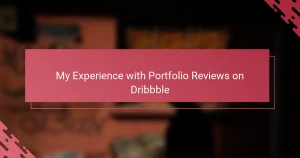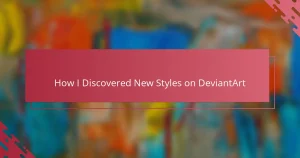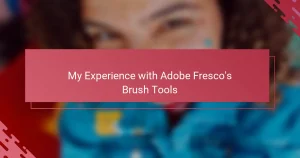Key takeaways
- Traditional art offers unique tactile experiences, while digital art provides flexibility and instant feedback, enhancing creative expression.
- Combining traditional and digital techniques allows artists to preserve raw authenticity while experimenting with colors and layers seamlessly.
- Effective portfolio presentation involves clarity, high-quality images, and context, enhancing viewer engagement and appreciation for the artistic journey.
- Embracing the strengths of both art forms can help overcome challenges related to merging physical and digital elements while maintaining artistic integrity.

Understanding Traditional and Digital Art
Traditional art has this tactile quality that always draws me in—the feel of a brush on canvas or the grain of paper under my pencil reminds me that every stroke is unique and unrepeatable. Have you ever noticed how the unpredictability of paint mixing can lead to happy accidents that surprise you?
Digital art, on the other hand, offers this incredible flexibility and instant feedback that traditional methods can’t match. I often find myself experimenting more boldly because I know I can undo or tweak anything without fear of ruining the whole piece. Isn’t that kind of freedom liberating for creativity?
Understanding these two worlds is like appreciating different languages of expression. Each has its own rhythm and possibilities, and blending them allows me to tell stories in ways that resonate more deeply than either could alone. Don’t you think that combining the best of both worlds opens up endless artistic horizons?
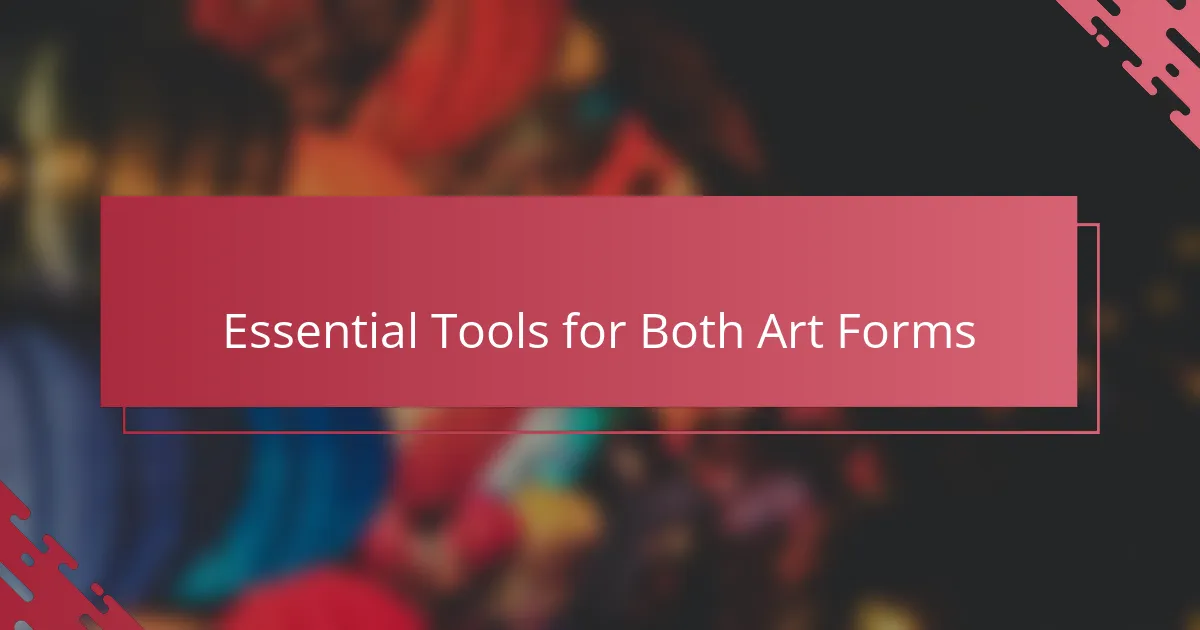
Essential Tools for Both Art Forms
When I dive into traditional art, my go-to tools are simple but essential: a set of quality pencils, smooth sketch paper, and a selection of watercolors. There’s something deeply satisfying about the way a well-sharpened pencil feels in my hand, almost like an extension of my thoughts. Have you ever noticed how choosing just the right brush can change the entire mood of a painting?
Switching to digital, my essentials shift to a reliable drawing tablet, pressure-sensitive stylus, and software like Procreate or Photoshop. The magic here is in how these tools respond instantly to every swipe and pressure, making every stroke feel natural despite the screen barrier. I often wonder—how did artists ever manage without layers and undo buttons?
What fascinates me most is how these tools don’t compete but complement each other. For instance, I might sketch rough ideas traditionally, then scan and refine them digitally, blending tactile warmth with slick precision. Isn’t it amazing how having a flexible toolkit transforms the way we approach creating art?
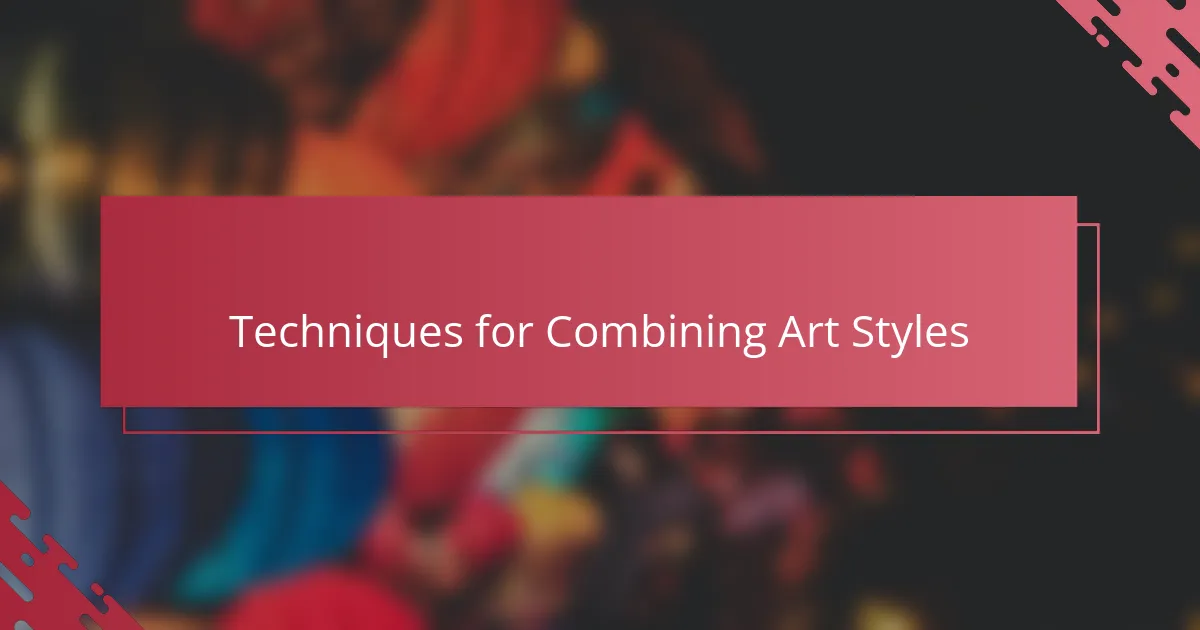
Techniques for Combining Art Styles
One technique I often use is starting with a traditional sketch to capture raw, spontaneous energy. There’s something about pencil lines on paper that digital tools can’t quite replicate, and I like to preserve that authenticity by scanning those sketches and building on them digitally. Have you ever felt that initial spark of a drawing just from the texture of paper alone?
Another method I enjoy is layering digital colors over traditional ink work. Once I’ve inked by hand, adding digital hues lets me experiment with color schemes without the pressure of permanent paint. It’s like having a playground for my ideas—I can try bold combos or subtle tones effortlessly, then decide which direction feels right. Isn’t that freedom what makes art so thrilling?
Sometimes, I mix the two styles by printing digital backgrounds and then adding hand-painted details on top. This blend gives my pieces a dynamic depth, where digital smoothness meets the unpredictability of brushstrokes. It’s a dance between control and chance, which keeps every artwork alive and surprising. Have you tried letting these different worlds enhance each other like that?
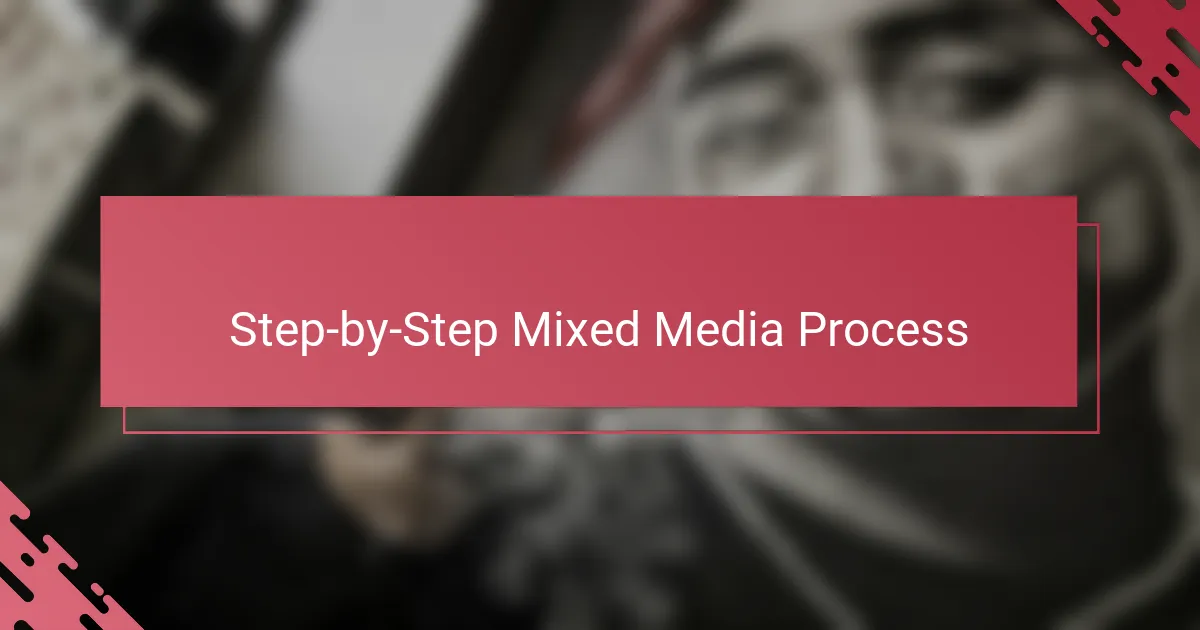
Step-by-Step Mixed Media Process
Starting my mixed media process, I usually lay down a loose traditional sketch on paper. There’s this irreplaceable immediacy in pencil strokes that sparks creativity in a way digital simply can’t. Have you ever felt that sudden flow when your hand moves freely, unaware of the final form it will take?
Next, I scan the sketch and bring it into my digital workspace. This is where magic happens—the ability to refine, erase, and play with layers instantly changes how I develop the piece. Don’t you find it addictive to experiment without worrying about wasting supplies or ruining hours of work?
Finally, I often print parts of the digital work to add hand-painted textures or highlights. This back-and-forth between screen and brush feels like a conversation between two art forms, each pushing the other to something richer. Isn’t that blending process a unique way to keep both spontaneity and precision alive in a single artwork?
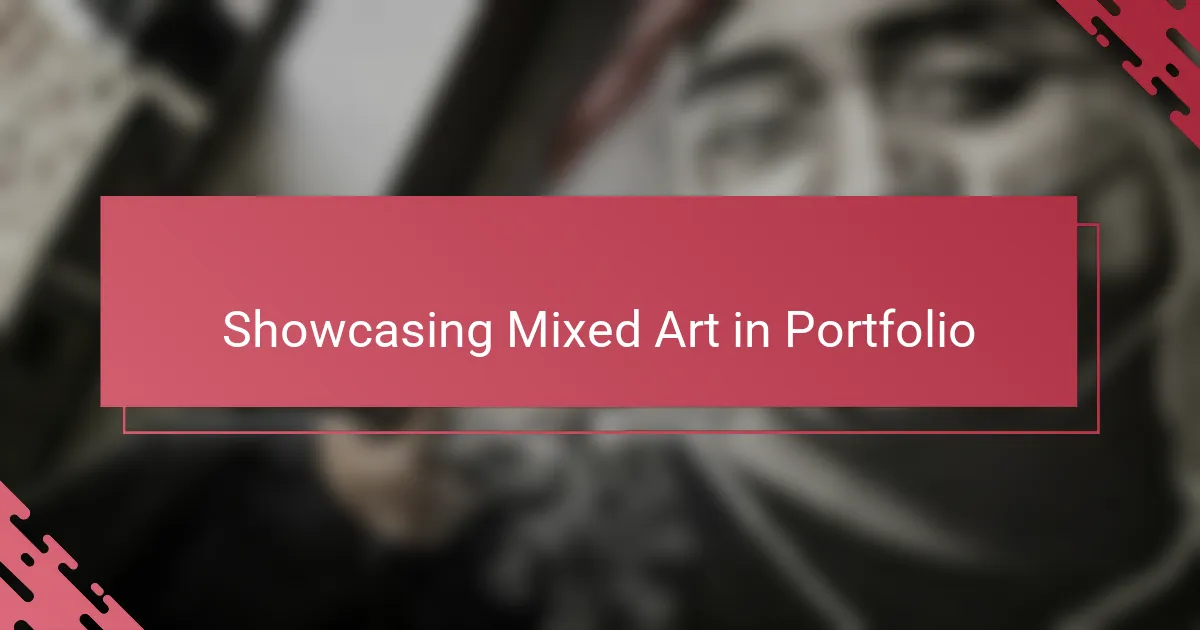
Showcasing Mixed Art in Portfolio
Showing mixed art in my portfolio is always a special moment—it’s where I get to share how these two contrasting worlds really come together. I like to include side-by-side images of the original traditional sketches alongside the finished digital piece. It’s revealing to see how a simple pencil line transforms through layers of digital color and effects, don’t you think?
I also find that presenting time-lapse videos or step-by-step breakdowns lets viewers dig deeper into my process. When I share these glimpses, I notice people appreciate the craft behind each blend of brush and pixel. Have you ever felt that watching someone’s creative journey makes the artwork even more meaningful?
Lastly, I pay close attention to organizing my portfolio so that mixed media pieces have their own space, highlighting the dialogue between both techniques. It’s like telling a story where each image builds on the last, showing how traditional textures and digital precision dance together. For me, that narrative is what truly connects with those who browse my work.
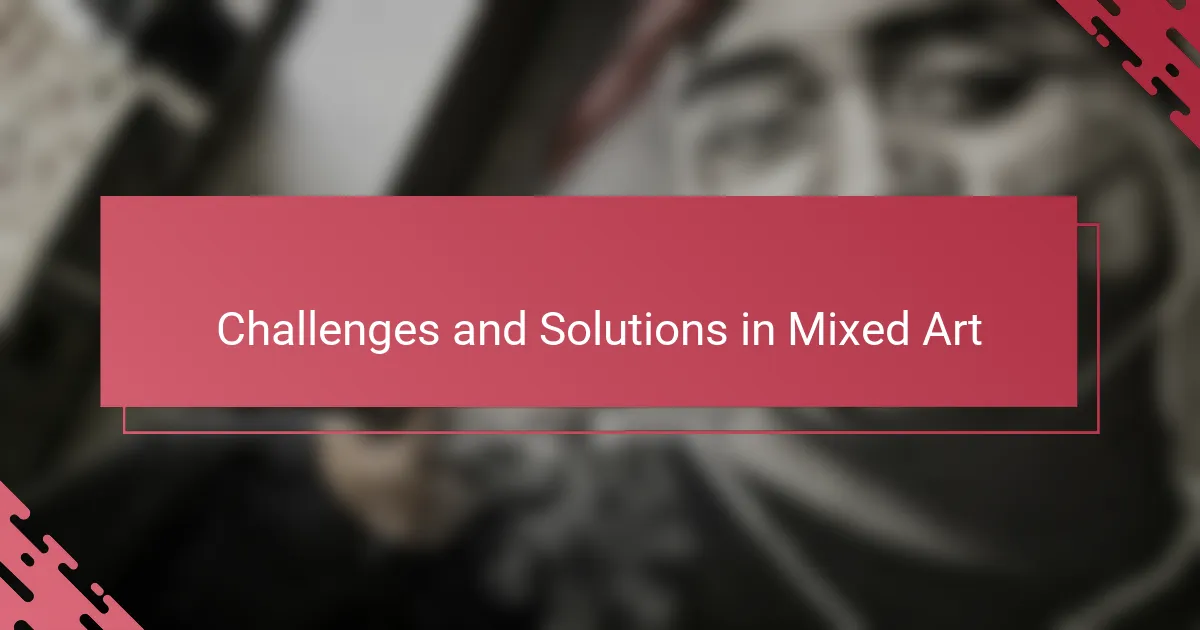
Challenges and Solutions in Mixed Art
Mixed art brings its own set of hurdles, especially when it comes to merging physical and digital layers seamlessly. I’ve struggled with color consistency when scanning traditional pieces; sometimes the hues just don’t translate well on screen, which can be frustrating. Have you ever spent hours tweaking digital adjustments just to capture that exact feeling of your original painting? It’s a delicate balancing act, but I’ve learned that calibrating my scanner and working with color profiles helps bridge that gap.
Another challenge I often face is managing the different resolutions and dimensions between media. Traditional artwork might be scanned at high resolution, but digital canvases operate differently, which sometimes leads to awkward scaling or quality loss. I found that setting up my digital workspace to match my scanned piece’s dimensions from the start saves me headaches down the line. Have you tried this? It’s like giving both worlds a common language to communicate in.
Then there’s the flow of switching mindsets—from the tactile, slower pace of traditional methods to the fast, fluid nature of digital art. Sometimes I get stuck trying to replicate the spontaneity I felt with my pencil once I’m inside the digital software. What helped me was embracing each medium’s strengths rather than forcing one to mimic the other. By treating digital as a playground for refinement rather than replication, my mixed pieces gained more personality and depth. Isn’t that the best part of mixing techniques—the freedom to let each shine in its own way?
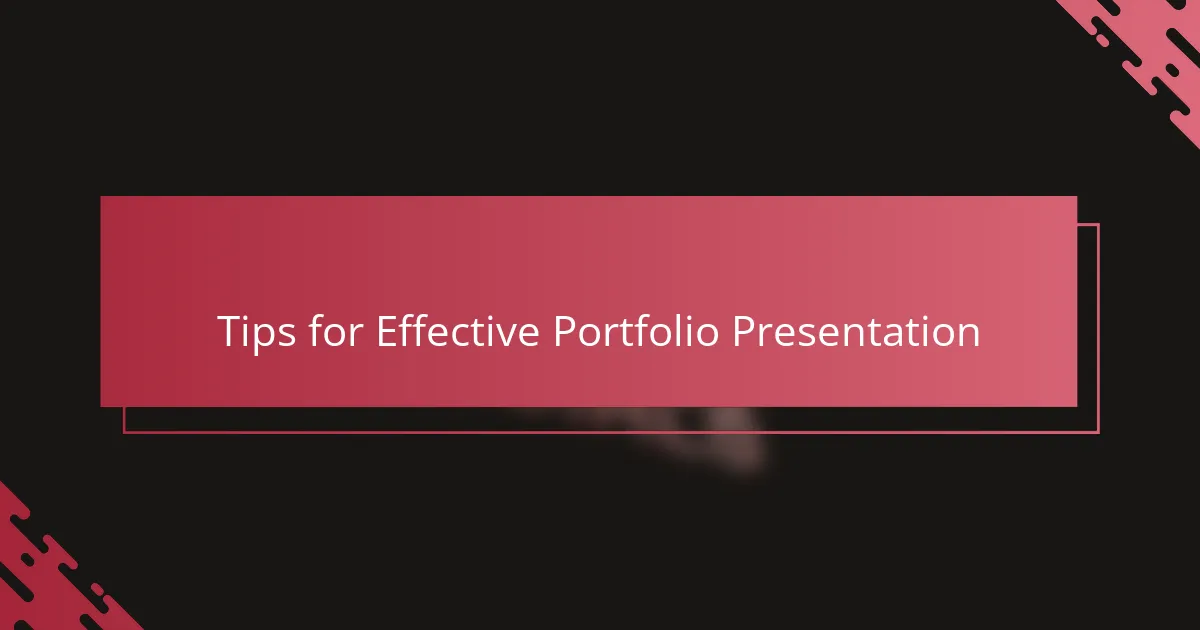
Tips for Effective Portfolio Presentation
Presenting my portfolio effectively has always been as important as the art itself. I’ve discovered that clarity and focus make a huge difference—nobody wants to scroll endlessly without a clear sense of what to look at. Have you ever felt lost in a portfolio with too many different styles thrown together? Keeping a consistent theme or narrative helps visitors connect with your work on a deeper level.
I also pay close attention to the quality of images. Early on, I overlooked this and uploaded photos that didn’t do justice to my textures and colors. Once I switched to high-resolution scans and properly edited digital files, the impact was immediate—suddenly, my art spoke louder and felt more professional. Don’t underestimate how much good lighting and sharpness enhance the viewer’s experience.
Finally, I like to create context around each piece by including brief notes or process shots. Sharing my “why” and “how” invites people into my creative world and makes the art feel more alive. Have you noticed how a little storytelling transforms a simple image into something memorable? It’s those personal touches that make your portfolio not just a gallery but an engaging journey.
